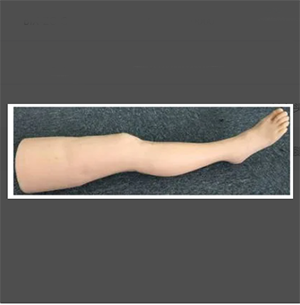

Article tag: Acupuncture leg Training Model| Acupuncture Training Model| BIX-ZC-IV|
The acupuncture leg training model not only provides students with a more intuitive learning platform, but also helps students improve operational accuracy and clinical confidence through repeated training and real-time feedback. Therefore, this training model can undoubtedly shorten the learning cycle from theory to practice, so that they can master and ...
Acupuncture and moxibustion, as a traditional Chinese medicine therapy, has played an important role in clinical treatment for a long time. However, learning acupuncture techniques requires not only a solid theoretical foundation, but also a wealth of clinical experience. Traditional teaching methods often make it difficult for students to master practical operation skills in a short time, which makes many medical students lack sufficient confidence in operation when facing complex clinical situations. Whether the emergence of acupuncture leg training model can effectively shorten the learning cycle from theory to practice has become a key issue in the field of medical education.
The challenge from theory to practice

Acupuncture leg Training Model
In the traditional acupuncture learning process, students need to understand the meridians, acupoints and different acupuncture techniques of the human body through books, lectures and other forms. However, relying solely on these theoretical knowledge, students often cannot master practical skills at an early stage. A major problem faced by many students is the lack of practical experience in the accurate positioning of acupuncture sites, the grasp of acupuncture depth, and the operational details in the treatment process, resulting in a high incidence of operational errors.
The value of acupuncture leg training model
The acupuncture leg training model provides an effective solution to this challenge. By simulating the structure and anatomical features of human legs, this training model can provide students with a near-real operating experience. Its application can help students practice and adjust acupuncture techniques repeatedly without clinical pressure. Specifically, the advantages of the model are reflected in the following aspects:
1. Enhance practical sense of operation: The acupuncture leg training model uses soft materials to imitate the real skin, muscle and bone structure, so that students can feel the real acupuncture resistance and response during operation. This immersive, practical training greatly enhances the students' operational perception and helps them better control the depth and Angle of acupuncture in clinical scenarios.
2. Repeated practice: Students can practice repeatedly on the model without worrying about affecting the safety and comfort of the patient. This repetitive training allows students to quickly accumulate operational experience, thus speeding up the transition from theory to practice.
3. Reduce error rate: Simulation exercises can help students identify and correct wrong operating habits in advance. For example, through repeated practice of accurately locating acupuncture points, students can gradually master precision acupuncture techniques and reduce the error rate in clinical operations.
4. Improved confidence: Due to the extensive training on the model, students will be able to have stronger operational confidence when entering clinical practice. Model training provides them with a "trial and error" space, which helps to reduce the tension and anxiety at the beginning of learning.
Data support: Effectiveness of shortening learning cycle
According to recent research data on the application of medical training models, students who use acupuncture training models can significantly improve the accuracy of acupuncture techniques in the short term. In a medical school experiment, for example, after two weeks of intensive training with acupuncture training model, students' operational accuracy improved by about 30%, and their confidence index was 25% higher than that of students who did not use the model. These data show that the acupuncture training model has significant advantages in facilitating students' transition from theoretical learning to practical practice.
Conclusion: The key to shorten the learning cycle
The acupuncture leg training model not only provides students with a more intuitive learning platform, but also helps students improve operational accuracy and clinical confidence through repeated training and real-time feedback. Therefore, this training model can undoubtedly shorten the learning cycle from theory to practice, so that they can master and master acupuncture techniques in a shorter time. Its application not only improves the teaching effect, but also lays a solid foundation for the future medical students to take the clinical post.